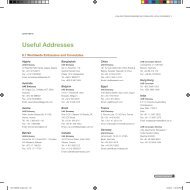Arab World Competitiveness Report 2011-2012 - World Economic ...
Arab World Competitiveness Report 2011-2012 - World Economic ...
Arab World Competitiveness Report 2011-2012 - World Economic ...
You also want an ePaper? Increase the reach of your titles
YUMPU automatically turns print PDFs into web optimized ePapers that Google loves.
Appendix B: Technical Notes and Sources for the Global <strong>Competitiveness</strong> Index<br />
<strong>Arab</strong> <strong>World</strong> <strong>Competitiveness</strong> <strong>Report</strong> <strong>2011</strong>-<strong>2012</strong><br />
36<br />
6.04 Extent and effect of taxation<br />
What impact does the level of taxes in your<br />
country have on incentives to work or invest? [1<br />
= significantly limits incentives to work or invest;<br />
7 = has no impact on incentives to work or<br />
invest] | 2010-11 weighted average<br />
Source: <strong>World</strong> <strong>Economic</strong> Forum, Executive<br />
Opinion Survey<br />
6.05 Total tax rate<br />
This variable is a combination of profit tax (% of<br />
profits), labor tax and contribution (% of profits),<br />
and other taxes (% of profits) | 2010<br />
The total tax rate measures the amount of<br />
taxes and mandatory contributions payable<br />
by a business in the second year of operation,<br />
expressed as a share of commercial profits. The<br />
total amount of taxes is the sum of five different<br />
types of taxes and contributions payable after<br />
accounting for deductions and exemptions: profit<br />
or corporate income taxes, social contributions<br />
and labor taxes paid by the employer, property<br />
taxes, turnover taxes, and other small taxes. For<br />
more details about the methodology employed<br />
and the assumptions made to compute this<br />
indicator, please visit http://www.doingbusiness.<br />
org/methodologysurveys/.<br />
Source: <strong>World</strong> Bank/International Finance<br />
Corporation, Doing Business <strong>2011</strong>: Making a<br />
Difference for Entrepreneurs<br />
6.06 Number of procedures required to start a<br />
business<br />
Number of procedures required to start a<br />
business | 2010<br />
For details about the methodology employed<br />
and the assumptions made to compute this<br />
indicator, please visit http://www.doingbusiness.<br />
org/methodologysurveys/.<br />
Source: <strong>World</strong> Bank/International Finance<br />
Corporation, Doing Business <strong>2011</strong>: Making a<br />
Difference for Entrepreneurs<br />
6.07 Time required to start a business<br />
Number of days required to start a business | 2010<br />
For details about the methodology employed<br />
and the assumptions made to compute this<br />
indicator, please visit http://www.doingbusiness.<br />
org/methodologysurveys/.<br />
Source: <strong>World</strong> Bank/International Finance<br />
Corporation, Doing Business <strong>2011</strong>: Making a<br />
Difference for Entrepreneurs<br />
6.08 Agricultural policy costs<br />
How would you assess the agricultural policy<br />
in your country? [1 = excessively burdensome<br />
for the economy; 7 = balances the interests of<br />
taxpayers, consumers, and producers] | 2010-11<br />
weighted average<br />
Source: <strong>World</strong> <strong>Economic</strong> Forum, Executive<br />
Opinion Survey<br />
6.09 Prevalence of trade barriers<br />
In your country, to what extent do tariff and nontariff<br />
barriers limit the ability of imported goods to<br />
compete in the domestic market? [1 = strongly<br />
limit; 7 = do not limit] | 2010-11 weighted average<br />
Source: <strong>World</strong> <strong>Economic</strong> Forum, Executive<br />
Opinion Survey<br />
6.1 Trade tariffs<br />
Trade-weighted average tariff rate | 2010<br />
This indicator is calculated as the average of the<br />
applied tariff rates, including preferential rates that<br />
a country applies to the rest of the world. The<br />
trade pattern of the importing country’s reference<br />
group (2007 data) is used as a weighting.<br />
Source: International Trade Centre<br />
6.11 Prevalence of foreign ownership<br />
How prevalent is foreign ownership of companies<br />
in your country? [1 = very rare; 7 = highly<br />
prevalent] | 2010-11 weighted average<br />
Source: <strong>World</strong> <strong>Economic</strong> Forum, Executive<br />
Opinion Survey<br />
6.12 Business impact of rules on FDI<br />
To what extent do rules governing foreign direct<br />
investment (FDI) encourage or discourage<br />
it? [1 = strongly discourage FDI; 7 = strongly<br />
encourage FDI] | 2010-11 weighted average<br />
Source: <strong>World</strong> <strong>Economic</strong> Forum, Executive<br />
Opinion Survey<br />
6.13 Burden of customs procedures<br />
How would you rate the level of efficiency of<br />
customs procedures (related to the entry and exit<br />
of merchandise) in your country? [1 = extremely<br />
inefficient; 7 = extremely efficient] | 2010-11<br />
weighted average<br />
Source: <strong>World</strong> <strong>Economic</strong> Forum, Executive<br />
Opinion Survey<br />
6.14 Imports as a percentage of GDP<br />
Imports of goods and services as a percentage<br />
of gross domestic product | 2010<br />
Source: <strong>World</strong> Trade Organization, Statistics<br />
Database: Time Series on International Trade<br />
(accessed July 4, <strong>2011</strong>); Economist Intelligence<br />
Unit, CountryData Database (accessed July 4,<br />
<strong>2011</strong>)





